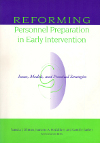The roles and responsibilities of early intervention professionals are changing and growing rapidly. This text improves upon traditional approaches to early intervention personnel preparation by showing instructors how to conceptualize and deliver truly interdisciplinary training. It offers advice on how to assess staff needs and evaluate outcomes, how to design and link preservice and inservice training, and how to integrate content and process to prepare a multidisciplinary audience. Specific chapters are devoted to cultural competence, family-centered practices, service coordination, child evaluations, natural environments, inclusive settings, and public policy.
Contents/Contributors/Foreword/Preface
Chapter 1: Ecological Perspectives on Personnel Preparation
Chapter 2: State Perspectives on Meeting Personnel Challenges
Chapter 3: Community-Based Approaches to Personnel Preparation
Chapter 4: Creating New Visions in Institutions of Higher Education
Chapter 5: Designing Effective Personnel Preparation for Early Intervention
Chapter 6: Needs Assessment and Evaluation in Early Intervention Personnel Preparation
Chapter 7: Follow-Up Strategies
Chapter 8: Supervision, Mentoring, and Coaching
Chapter 9: From Monologues to Skilled Dialogues
Chapter 10: Guiding Practitioners Toward Valuing and Implementing Family-Centered Practices
Chapter 11: Service Coordination in Early Intervention
Chapter 12: Preparing Practitioners for Getting the Most Out of Child Assessment
Chapter 13: Preparing Practitioners for Planning Intervention for Natural Environments
Chapter 14: Building Effective Early Intervention Teamwork
Chapter 15: Preparing Practitioners to Provide Early Intervention Services in Inclusive Settings
Chapter 16: Early Intervention Public Policy Analysis
Chapter 17: Parent-Professional Partnerships in Preservice and Inservice Education
Chapter 18: Designing and Implementing Innovative, Interdisciplinary Practica
Chapter 19: Distance Education in Early Intervention Personnel Preparation
Chapter 20: A Team-Based Model to Improve Early Intervention Programs: Linking Preservice and Inservice
Chapter 21: Putting It All Together
Epilogue
Index

